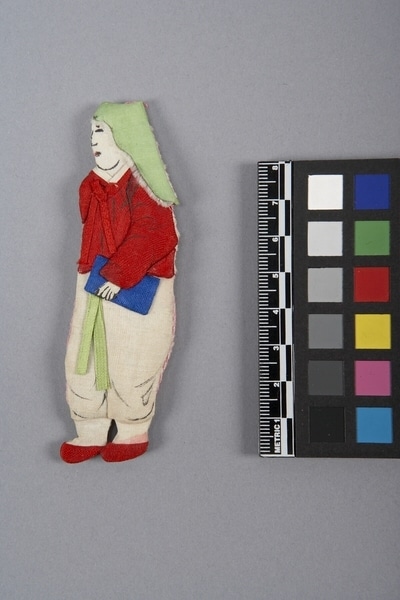Doll Item Number: Ed1.110 from the MOA: University of British Columbia

Description
Figure representing a person on a flat backing of white paper. Front view is depicted of the figure which is made of cloth lightly padded to give a three-dimensional effect having each portion made of a separate piece of cloth with painted details. Hands are made of paper. Face is made of white silk. The figure's left hand is holding a dark blue rectangular object. Wearing a light green head cover edged in a representation of white fur, a red silk jacket tied with ribbon of the same colour on the upper right side, loose white silk trousers tied with a light green ribbon, white socks, and low red shoes. Two pieces of white flannel hemmed in light red-pink silk with a loop of the same at the top are sewed to the paper backing.
History Of Use
Figure represents boy of late 19th to early 20th century, probably wearing a fur-lined hood (hambaui). Such figures were made during the time when Korea was first open to the outside world (after the mid 1890s), probably as gifts to present to missionaries or other visitors from foreign countries. Flat dolls like these were very popular during the period 1910-20. Before that time, shamans made dolls that they sold to their clients, as images of those the clients wanted to exorcise. Simple dolls were made of straw for children to play with. After Korea opened, people began to see dolls as artistic objects. They were made in workshops by masters, using authentic fabrics whenever possible, as their purpose was to introduce foreigners to Korean society. Boys of the official “yangban” class dressed in this way to go to school. Books were wrapped in a cloth “Bo-ja-gui” to be carried. They wore padded shoes and padded hoods, “Nam-ba-wi”, in winter.
Narrative
Collected by J. H. Morris while he was chief engineer for Seoul Railway, Korea.
Iconographic Meaning
The light green colour of his hood and trouser ties indicates that the wearer is a young boy. His silk clothes and hood show that he is of the official “yangban” class.
Specific Techniques
The clothing was stitched around the edge and then a layer was added inside the clothing. Each section was separately applied and pasted in place. The details were finely painted.
Item History
- Made in Korea during 1910
- Collected between 1910 and 1939
- Owned by Marion Stephan before August 1964
- Received from Marion Stephan (Donor) during August 1964
What
- Name
- Doll
- Identification Number
- Ed1.110
- Type of Item
- doll
- Material
- paper, silk fibre, cotton fibre, rayon fibre ?, paint and paste adhesive
- Manufacturing Technique
- spun, woven, cut, painted, sewn and pasted
- Overall
- height 9.8 cm, width 3.4 cm, depth 0.5 cm
Who
- Culture
- Korean
- Previous Owner
- Marion Stephan
- Received from
- Marion Stephan (Donor)
Where
- Holding Institution
- MOA: University of British Columbia
- Made in
- Korea
When
- Creation Date
- during 1910
- Collection Date
- between 1910 and 1939
- Ownership Date
- before August 1964
- Acquisition Date
- during August 1964
Other
- Condition
- good
- Current Location
- Case 77
- Accession Number
- 0113/0013